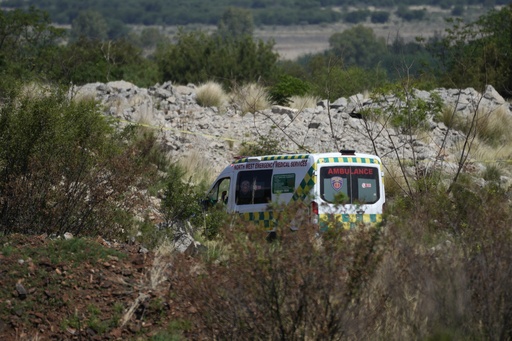
In South Africa, authorities are currently facing a standoff with a group of illegal miners who remain underground at an abandoned mine in Stilfontein. These miners are reportedly reluctant to emerge due to fears of being apprehended by police officers stationed at the scene.
Located in the North West province, this mine has been a site for unauthorized mining activities as individuals search for gold in places where operations have ceased. Illegal mining remains a persistent issue in South Africa, having been a significant problem for many years.
The ongoing standoff has now extended into its third week, drawing attention to the widespread issue of illegal mining in the country. Initially, police had restricted essential supplies from reaching the miners; however, they have since changed tactics, providing the miners with packets of instant porridge in an effort to coax them to the surface.
The illegal mining trend in South Africa has been aggravated by the country’s once-thriving mining industry. Those involved in illegal mining are commonly referred to as zama-zamas, a term which means “hustlers” in Zulu. These miners often scour abandoned sites for gold and other valuable metals, navigating the dangers posed by being in spaces that are no longer safe.
Authorities regard illegal miners as a threat, given that many are armed and engage in violent altercations over territory. The trade is mainly operated by migrants entering the country illegally from neighboring regions such as Lesotho, Zimbabwe, and Mozambique. Although police have announced some successes in capturing illegal miners, they stress that real progress cannot be made without dismantling the powerful criminal organizations that control these lucrative mining operations.
South African officials estimate that around 6,000 mines are currently abandoned, leading to an annual revenue loss of approximately $1 billion due to illegal mining activities.
To combat the ongoing issue, law enforcement and military personnel have collaborated in a specialized operation termed “Close the Hole” (or “Vala Umgodi” in Zulu) since December. This initiative aims to disrupt the supply chain of the illegal miners by limiting the delivery of essential resources.
Typically, the zama-zamas remain underground for extended durations, expecting those above ground to provide them with food, water, and other necessities. However, during the operation, police have targeted individuals attempting to supply these illegal miners. Entrances for supplies have also been secured, pressuring those underground to emerge as their provisions diminish.
As a result of the operation, authorities have reported the apprehension of 14,000 illegal miners. Law enforcement has also recovered $277,000 in cash and uncut diamonds valued at approximately $1.8 million. Recently, in a similar incident in Orkney, which lies in the same province as Stilfontein, 565 illegal miners were arrested after surfacing once their supplies had dwindled.
In Stilfontein, attempts to negotiate the exit of the miners were initially led by the local community, but the police later assumed control of the situation. The mine reaches depths of 2,500 meters (8,000 feet), making any forced extraction of the potentially armed zama-zamas a risky endeavor. So far, three miners have reportedly come out, and a decomposed body believed to belong to one of the miners has been retrieved, with authorities working to identify the individual and determine the cause of death.
There are conflicting estimates regarding the number of illegal miners still underground, with community inputs suggesting around 4,500, while police have indicated the figure is likely between 350 and 400. Plans are being formulated by provincial authorities to utilize a “cage” to safely lift the miners to the surface in small groups, though any operation will first require thorough safety assessments.
Additionally, the government is considering the deployment of a camera to gain a clearer understanding of the underground situation. A civil society organization has also approached the courts, seeking to compel authorities to allow supplies to reach the miners. However, the government maintains that the miners are not trapped, but rather are choosing to stay underground to evade arrest.
